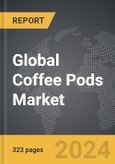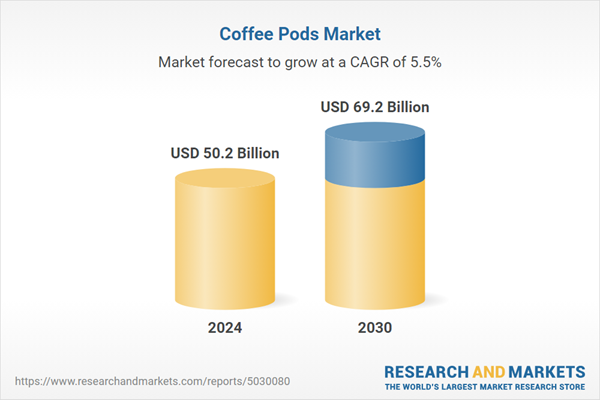The global market for Coffee Pods was valued at US$50.2 Billion in 2024 and is projected to reach US$69.2 Billion by 2030, growing at a CAGR of 5.5% from 2024 to 2030. This comprehensive report provides an in-depth analysis of market trends, drivers, and forecasts, helping you make informed business decisions. The report includes the most recent global tariff developments and how they impact the Coffee Pods market.
Segments: Form (Capsules, Soft, Hard); Distribution Channel (Hypermarkets & Supermarkets, Convenience Stores, On-Trade, Other Distribution Channels).
Geographic Regions/Countries: World; United States; Canada; Japan; China; Europe (France; Germany; Italy; United Kingdom; and Rest of Europe); Asia-Pacific; Rest of World.
The analysts continuously track trade developments worldwide, drawing insights from leading global economists and over 200 industry and policy institutions, including think tanks, trade organizations, and national economic advisory bodies. This intelligence is integrated into forecasting models to provide timely, data-driven analysis of emerging risks and opportunities.
Global Coffee Pods Market - Key Trends and Drivers Summarized
What Are Coffee Pods and How Have They Changed the Coffee Experience?
Coffee pods, small pre-packaged containers filled with ground coffee, have revolutionized the way people consume coffee, offering convenience, consistency, and quality in a single-serving format. These pods are designed to be used with single-serve coffee machines, allowing users to brew a cup of coffee in just a matter of seconds. Introduced in the early 2000s, coffee pods have evolved to become one of the most popular methods of coffee preparation, especially in homes and offices. The pre-measured quantities of coffee, sealed to maintain freshness, ensure that every cup has the same taste and strength, addressing the variability that often comes with traditional coffee brewing methods like drip coffee makers or French presses. The rise of coffee pods has been fueled by their ease of use, eliminating the need for grinding beans, measuring portions, or dealing with messy coffee grounds. These factors, combined with the rapid expansion of single-serve coffee machine options from major brands like Nespresso, Keurig, and others, have transformed coffee consumption into a more streamlined and personalized experience for millions of people worldwide.How Have Coffee Pods Adapted to the Modern Consumer’s Needs?
In recent years, coffee pods have become more diverse and sophisticated to meet the changing preferences and demands of modern consumers. One of the most significant trends is the introduction of a wide variety of flavors, roast levels, and even specialty coffee blends, catering to different taste preferences. Consumers now have access to a range of options from light to dark roasts, flavored coffee pods like vanilla or hazelnut, and even premium espresso varieties. Many companies have also responded to the growing interest in organic and fair-trade products by offering ethically sourced coffee pods. As health-conscious consumers pay more attention to the origins of their food and beverages, sustainability has become a key selling point in the coffee pod market. Furthermore, the demand for environmental responsibility has spurred the development of recyclable and biodegradable coffee pods, addressing concerns about the environmental impact of single-use packaging. This shift is particularly important as more consumers seek eco-friendly alternatives to reduce their carbon footprint while still enjoying the convenience of single-serve coffee. In addition, the rise of compact, user-friendly coffee machines has made coffee pods even more accessible, fitting easily into homes, offices, and even small apartments where traditional coffee makers may not be practical. As a result, coffee pods have become a convenient and increasingly customizable option for consumers looking for a quick, hassle-free coffee experience without sacrificing quality or sustainability.What Innovations Are Shaping the Future of Coffee Pods?
The coffee pod industry continues to evolve through innovation, with both technology and sustainability being central themes in its future growth. One of the most significant technological advancements is the development of smart coffee machines that are compatible with a variety of coffee pods and can be controlled remotely via smartphone apps. These smart devices allow users to schedule brews, adjust brewing temperatures, and choose their preferred strength settings, further personalizing the coffee experience. Some machines also feature Wi-Fi connectivity, which enables updates and integrations with voice-activated assistants like Amazon’s Alexa or Google Home, blending convenience with modern technology. On the sustainability front, more companies are investing in the research and development of eco-friendly coffee pods. These include compostable pods made from plant-based materials and aluminum capsules designed for easy recycling. The goal is to reduce the environmental impact of the millions of coffee pods used daily around the world. This shift is driven not only by regulatory pressures and consumer demand but also by corporate responsibility initiatives from major players in the industry. There is also a rising trend in reusable coffee pods, which can be filled with any ground coffee of the user’s choice, reducing single-use waste. Additionally, innovations in coffee pod packaging are ensuring that the coffee inside stays fresh longer, using improved sealing technologies that preserve flavor and aroma without the need for excessive packaging.What’s Driving Growth in the Coffee Pod Market?
The growth in the coffee pod market is driven by several factors, including technological advancements, evolving consumer behavior, and the increasing demand for convenience. One of the primary drivers is the continued development of more advanced single-serve coffee machines, which offer greater ease of use, customization options, and compatibility with a wider range of coffee pods. As these machines become more affordable and accessible, especially in emerging markets, the demand for coffee pods is expected to rise accordingly. Additionally, the growing trend of at-home coffee consumption has led to more people investing in home brewing systems, further fueling the demand for coffee pods. Another significant growth factor is the increasing consumer preference for premium, specialty coffee products. As consumers become more discerning about the quality and origin of their coffee, there is a growing market for high-end, single-origin, and artisanal coffee pods. These pods offer a level of convenience without compromising on quality, catering to coffee enthusiasts who want a gourmet experience at home. Moreover, the rise of eco-conscious consumerism has driven the demand for sustainable and ethically sourced coffee pods. Companies that offer recyclable, compostable, or reusable pod options are gaining a competitive edge as more consumers prioritize environmental responsibility in their purchasing decisions. Lastly, the expansion of e-commerce platforms and subscription services for coffee pods has made it easier for consumers to access a wide variety of products, contributing to the steady growth of the market. The ability to receive coffee pods directly to their doorstep on a regular basis appeals to consumers looking for convenience and variety, ensuring that the coffee pod market will continue to expand in the coming years.Report Scope
The report analyzes the Coffee Pods market, presented in terms of units. The analysis covers the key segments and geographic regions outlined below.Segments: Form (Capsules, Soft, Hard); Distribution Channel (Hypermarkets & Supermarkets, Convenience Stores, On-Trade, Other Distribution Channels).
Geographic Regions/Countries: World; United States; Canada; Japan; China; Europe (France; Germany; Italy; United Kingdom; and Rest of Europe); Asia-Pacific; Rest of World.
Key Insights:
- Market Growth: Understand the significant growth trajectory of the Capsules Form segment, which is expected to reach US$40.7 Billion by 2030 with a CAGR of a 6.2%. The Soft Form segment is also set to grow at 4.1% CAGR over the analysis period.
- Regional Analysis: Gain insights into the U.S. market, valued at $13.9 Billion in 2024, and China, forecasted to grow at an impressive 5.3% CAGR to reach $10.9 Billion by 2030. Discover growth trends in other key regions, including Japan, Canada, Germany, and the Asia-Pacific.
Why You Should Buy This Report:
- Detailed Market Analysis: Access a thorough analysis of the Global Coffee Pods Market, covering all major geographic regions and market segments.
- Competitive Insights: Get an overview of the competitive landscape, including the market presence of major players across different geographies.
- Future Trends and Drivers: Understand the key trends and drivers shaping the future of the Global Coffee Pods Market.
- Actionable Insights: Benefit from actionable insights that can help you identify new revenue opportunities and make strategic business decisions.
Key Questions Answered:
- How is the Global Coffee Pods Market expected to evolve by 2030?
- What are the main drivers and restraints affecting the market?
- Which market segments will grow the most over the forecast period?
- How will market shares for different regions and segments change by 2030?
- Who are the leading players in the market, and what are their prospects?
Report Features:
- Comprehensive Market Data: Independent analysis of annual sales and market forecasts in US$ Million from 2024 to 2030.
- In-Depth Regional Analysis: Detailed insights into key markets, including the U.S., China, Japan, Canada, Europe, Asia-Pacific, Latin America, Middle East, and Africa.
- Company Profiles: Coverage of players such as Coffechino, Dunkin Donuts, Gloria Jean's Coffees International Pty. Ltd., Jacobs Douwe Egberts B.V., Keurig Green Mountain, Inc. and more.
- Complimentary Updates: Receive free report updates for one year to keep you informed of the latest market developments.
Some of the 42 companies featured in this Coffee Pods market report include:
- Coffechino
- Dunkin Donuts
- Gloria Jean's Coffees International Pty. Ltd.
- Jacobs Douwe Egberts B.V.
- Keurig Green Mountain, Inc.
- Luigi Lavazza SpA
- Melitta North America, Inc.
- Nespresso Club
- Seattle's Best Coffee LLC.
- Starbucks Coffee Company
- The Folger Coffee Company
- The Kraft Heinz Company
Tariff Impact Analysis: Key Insights for 2025
Global tariff negotiations across 180+ countries are reshaping supply chains, costs, and competitiveness. This report reflects the latest developments as of April 2025 and incorporates forward-looking insights into the market outlook.The analysts continuously track trade developments worldwide, drawing insights from leading global economists and over 200 industry and policy institutions, including think tanks, trade organizations, and national economic advisory bodies. This intelligence is integrated into forecasting models to provide timely, data-driven analysis of emerging risks and opportunities.
What’s Included in This Edition:
- Tariff-adjusted market forecasts by region and segment
- Analysis of cost and supply chain implications by sourcing and trade exposure
- Strategic insights into geographic shifts
Buyers receive a free July 2025 update with:
- Finalized tariff impacts and new trade agreement effects
- Updated projections reflecting global sourcing and cost shifts
- Expanded country-specific coverage across the industry
Table of Contents
I. METHODOLOGYII. EXECUTIVE SUMMARY2. FOCUS ON SELECT PLAYERSIII. MARKET ANALYSISIV. COMPETITION
1. MARKET OVERVIEW
3. MARKET TRENDS & DRIVERS
4. GLOBAL MARKET PERSPECTIVE
UNITED STATES
CANADA
JAPAN
CHINA
EUROPE
FRANCE
GERMANY
ITALY
UNITED KINGDOM
REST OF EUROPE
ASIA-PACIFIC
REST OF WORLD
Companies Mentioned (Partial List)
A selection of companies mentioned in this report includes, but is not limited to:
- Coffechino
- Dunkin Donuts
- Gloria Jean's Coffees International Pty. Ltd.
- Jacobs Douwe Egberts B.V.
- Keurig Green Mountain, Inc.
- Luigi Lavazza SpA
- Melitta North America, Inc.
- Nespresso Club
- Seattle's Best Coffee LLC.
- Starbucks Coffee Company
- The Folger Coffee Company
- The Kraft Heinz Company
Table Information
| Report Attribute | Details |
|---|---|
| No. of Pages | 323 |
| Published | April 2025 |
| Forecast Period | 2024 - 2030 |
| Estimated Market Value ( USD | $ 50.2 Billion |
| Forecasted Market Value ( USD | $ 69.2 Billion |
| Compound Annual Growth Rate | 5.5% |
| Regions Covered | Global |









